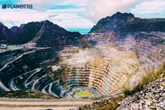Inaugural lithium drilling programme approved for Stelar’s Trident Project
Published by Jane Bentham,
Editorial Assistant
Global Mining Review,
Critical minerals explorer Stelar Metals Limited has announced that the NSW Resource Regulator has approved the proposed inaugural drill programme at the Trident Lithium Project and that additionally, all proposed areas have all been cleared for drilling by the Wilyakali Aboriginal Corporation (WAC).
The Trident Lithium Project extends over the 20 km strike length of the Euriowie Tin Pegmatite Field and is highly prospective for hard-rock lithium mineralisation. Mapped LCT-type pegmatites vary in size but can be up to 100 m wide and extend in outcrop for over 1 km in length. Trident was one of Australia's first lithium and tin mining provinces, highlighting the potential fertility and large scale of Stelar’s lithium-rich pegmatite system.
Stelar’s first hard-rock lithium drill programme at Trident, comprising approximately 3000 m RC drilling, is scheduled to start in early November. It will be the first ever drill programme to test the historic lithium mines at Trident, Sceptre, Lady Don, and Triumph, and the recently mapped LCT-pegmatites at Stag and Gloria.
Stelar Metals CEO, Colin Skidmore, said: “Stelar’s team is to be congratulated for the enormous effort that has gone into working up this project since acquisition earlier this year, both technically and through robust stakeholder engagement. This has resulted in the drilling being approved on schedule and the team looks forward to participating in this exciting first drill programme at Trident.”
Read the article online at: https://www.globalminingreview.com/mining/25102023/inaugural-lithium-drilling-programme-approved-for-stelars-trident-project/
You might also like
The dual threat facing modern mining
Extreme weather is reshaping mining – driving floods, drought, and costly disruptions. Long-range environmental forecasting offers a path to safer operations, stronger infrastructure, and planning amid a rapidly intensifying water cycle.


